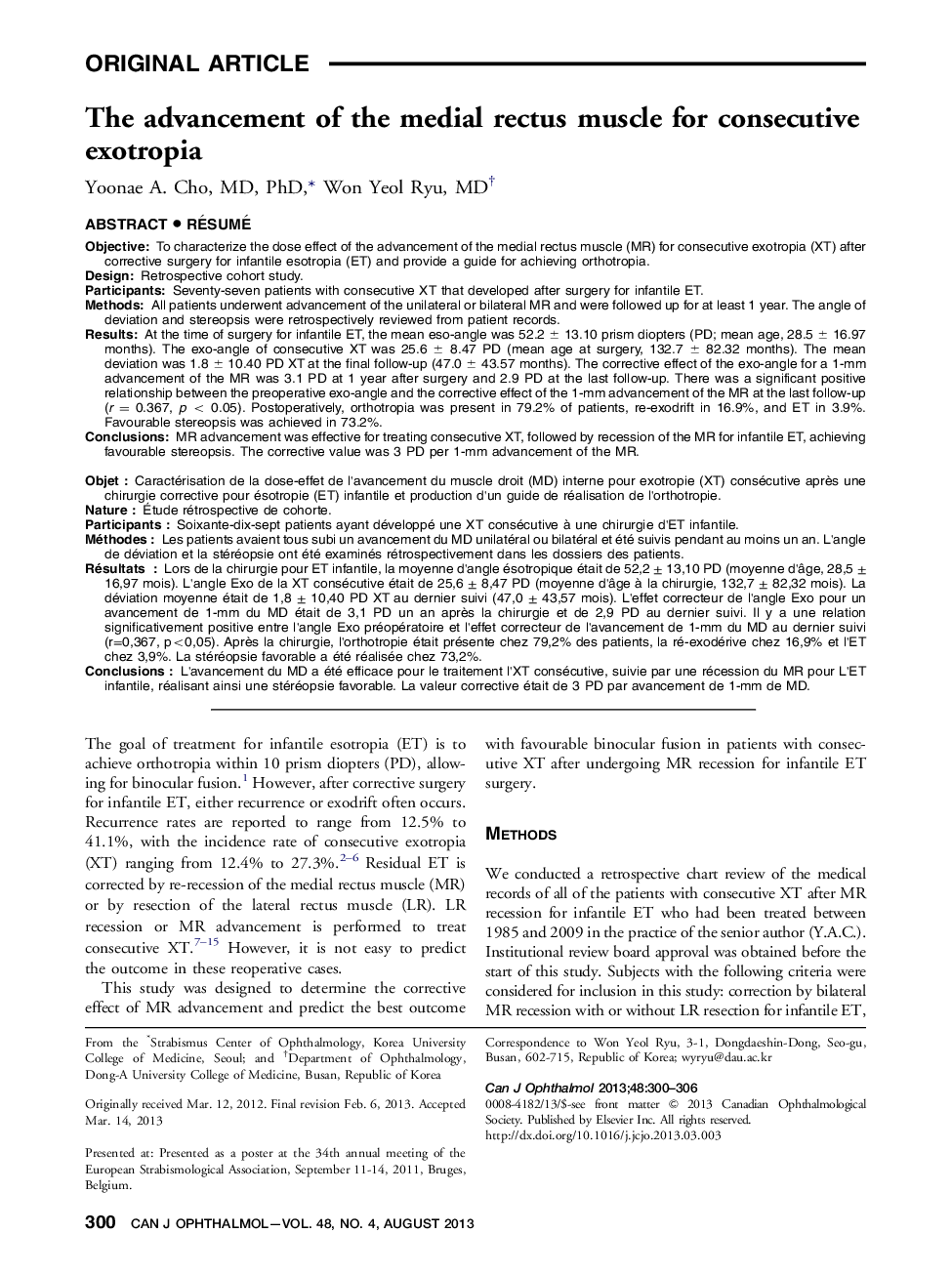| Article ID | Journal | Published Year | Pages | File Type |
|---|---|---|---|---|
| 4009534 | Canadian Journal of Ophthalmology / Journal Canadien d'Ophtalmologie | 2013 | 7 Pages |
ObjectiveTo characterize the dose effect of the advancement of the medial rectus muscle (MR) for consecutive exotropia (XT) after corrective surgery for infantile esotropia (ET) and provide a guide for achieving orthotropia.DesignRetrospective cohort study.ParticipantsSeventy-seven patients with consecutive XT that developed after surgery for infantile ET.MethodsAll patients underwent advancement of the unilateral or bilateral MR and were followed up for at least 1 year. The angle of deviation and stereopsis were retrospectively reviewed from patient records.ResultsAt the time of surgery for infantile ET, the mean eso-angle was 52.2 ± 13.10 prism diopters (PD; mean age, 28.5 ± 16.97 months). The exo-angle of consecutive XT was 25.6 ± 8.47 PD (mean age at surgery, 132.7 ± 82.32 months). The mean deviation was 1.8 ± 10.40 PD XT at the final follow-up (47.0 ± 43.57 months). The corrective effect of the exo-angle for a 1-mm advancement of the MR was 3.1 PD at 1 year after surgery and 2.9 PD at the last follow-up. There was a significant positive relationship between the preoperative exo-angle and the corrective effect of the 1-mm advancement of the MR at the last follow-up (r = 0.367, p < 0.05). Postoperatively, orthotropia was present in 79.2% of patients, re-exodrift in 16.9%, and ET in 3.9%. Favourable stereopsis was achieved in 73.2%.ConclusionsMR advancement was effective for treating consecutive XT, followed by recession of the MR for infantile ET, achieving favourable stereopsis. The corrective value was 3 PD per 1-mm advancement of the MR.
RésuméObjetCaractérisation de la dose-effet de l'avancement du muscle droit (MD) interne pour exotropie (XT) consécutive après une chirurgie corrective pour ésotropie (ET) infantile et production d'un guide de réalisation de l'orthotropie.NatureÉtude rétrospective de cohorte.ParticipantsSoixante-dix-sept patients ayant développé une XT consécutive à une chirurgie d'ET infantile.MéthodesLes patients avaient tous subi un avancement du MD unilatéral ou bilatéral et été suivis pendant au moins un an. L'angle de déviation et la stéréopsie ont été examinés rétrospectivement dans les dossiers des patients.RésultatsLors de la chirurgie pour ET infantile, la moyenne d'angle ésotropique était de 52,2 ± 13,10 PD (moyenne d'âge, 28,5 ± 16,97 mois). L'angle Exo de la XT consécutive était de 25,6 ± 8,47 PD (moyenne d'âge à la chirurgie, 132,7 ± 82,32 mois). La déviation moyenne était de 1,8 ± 10,40 PD XT au dernier suivi (47,0 ± 43,57 mois). L'effet correcteur de l'angle Exo pour un avancement de 1-mm du MD était de 3,1 PD un an après la chirurgie et de 2,9 PD au dernier suivi. Il y a une relation significativement positive entre l'angle Exo préopératoire et l'effet correcteur de l'avancement de 1-mm du MD au dernier suivi (r=0,367, p<0,05). Après la chirurgie, l'orthotropie était présente chez 79,2% des patients, la ré-exodérive chez 16,9% et l'ET chez 3,9%. La stéréopsie favorable a été réalisée chez 73,2%.ConclusionsL'avancement du MD a été efficace pour le traitement l'XT consécutive, suivie par une récession du MR pour L'ET infantile, réalisant ainsi une stéréopsie favorable. La valeur corrective était de 3 PD par avancement de 1-mm de MD.
